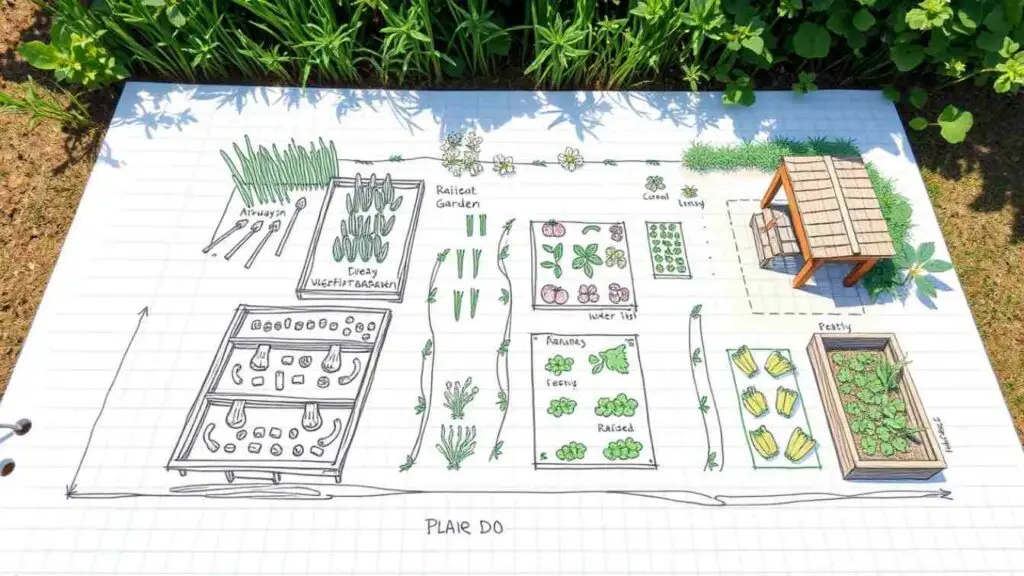Planning a vegetable garden is both an exciting and rewarding endeavor. Whether you’re a seasoned gardener or just starting out, understanding the principles of layout and spacing is crucial for maximizing your yield and ensuring healthy plant growth. In this comprehensive guide, we’ll explore everything you need to know about designing an efficient vegetable garden layout, including tips on spacing, companion planting, and optimizing your space. By the end of this article, you’ll have all the tools you need to create a thriving garden that works for your unique needs.
Why Proper Layout and Spacing Matter
Before diving into specific plans, it’s important to understand why layout and spacing are so critical to your garden’s success. Proper planning ensures:
- Optimal Sunlight Exposure: Vegetables need at least 6–8 hours of sunlight daily. A well-thought-out layout maximizes sun exposure for all plants.
- Efficient Use of Space: Strategic spacing prevents overcrowding, which can lead to competition for nutrients and poor air circulation.
- Improved Accessibility: A good layout makes it easier to tend to your plants without stepping on soil or damaging crops.
- Disease Prevention: Proper spacing reduces the risk of fungal diseases by allowing air to circulate freely between plants.
Step-by-Step Guide to Designing Your Vegetable Garden Layout

1. Assess Your Space
The first step in creating a vegetable garden plan is evaluating the available space. Consider the following:
- Sunlight Patterns: Observe how sunlight moves across your yard throughout the day.
- Soil Quality: Test your soil to determine its pH level and nutrient content.
- Access to Water: Ensure your garden is near a water source for easy irrigation.
2. Choose the Right Garden Style
There are several popular garden styles to consider:
- Raised Beds: Ideal for small spaces and areas with poor soil quality.
- In-Ground Gardens: Best for larger plots with rich, fertile soil.
- Container Gardens: Perfect for patios, balconies, or urban settings.
- Vertical Gardens: Great for maximizing limited space while growing climbing plants like beans and cucumbers.
3. Plan Your Plant Placement
When deciding where to place each type of vegetable, keep these factors in mind:
- Plant Height: Taller plants (like tomatoes) should be placed on the north side of the garden to avoid shading shorter plants.
- Companion Planting: Some plants grow better when paired together. For example, basil repels pests that attack tomatoes, making them excellent companions.
- Succession Planting: Stagger planting times to ensure a continuous harvest throughout the growing season.
Learn everything about growing cherry trees from seed with this beginner-friendly guide.
Understanding Vegetable Garden Spacing
Proper spacing is one of the most overlooked aspects of gardening, yet it directly impacts plant health and productivity. Here’s a breakdown of spacing guidelines for common vegetables:
Leafy Greens (e.g., lettuce, spinach)
- Spacing: 6–12 inches apart.
- Why It Matters: These plants require enough room for their leaves to spread but not so much that they waste valuable space.
Root Vegetables (e.g., carrots, radishes)
- Spacing: 2–4 inches apart.
- Why It Matters: Overcrowding can result in stunted root development and misshapen vegetables.
Fruit-Bearing Plants (e.g., tomatoes, peppers)
- Spacing: 18–24 inches apart.
- Why It Matters: These plants need ample space for air circulation to prevent diseases like blight.
Vining Crops (e.g., cucumbers, squash)
- Spacing: 24–36 inches apart.
- Why It Matters: Vining plants spread quickly, so giving them room ensures they don’t overwhelm neighboring crops.
Tips for Maximizing Space in Small Gardens
If you’re working with limited space, here are some clever strategies to make the most of it:
- Interplanting: Grow fast-maturing crops (like radishes) alongside slower-growing ones (like peppers). The radishes will be harvested before the peppers need more space.
- Square Foot Gardening: Divide your garden into 1-foot squares and plant according to the recommended spacing for each crop within each square.
- Vertical Supports: Use trellises, cages, or stakes to train vining plants upward instead of outward.
Companion Planting: Boosting Growth Through Strategic Pairings
Companion planting involves grouping certain plants together to enhance growth, deter pests, and improve flavor. Here are some tried-and-true combinations:
- Tomatoes + Basil: Basil improves tomato flavor and repels harmful insects.
- Carrots + Onions: Onions deter carrot flies, while carrots help aerate the soil around onions.
- Corn + Beans + Squash (The Three Sisters): Corn provides support for beans, beans fix nitrogen in the soil, and squash acts as a natural mulch to retain moisture.
Common Mistakes to Avoid When Planning Your Garden
Even experienced gardeners can fall into traps when designing their layouts. Here’s what to watch out for:
- Overcrowding: Resist the temptation to squeeze too many plants into a small area.
- Ignoring Microclimates: Pay attention to variations in sunlight, wind, and moisture levels within your garden.
- Poor Pathway Design: Narrow paths can make it difficult to access your plants without compacting the soil.
Tools and Resources for Planning Your Vegetable Garden
To simplify the planning process, consider using these helpful tools:
- Garden Planner Apps: Apps like Gardenize and SmartGarden offer drag-and-drop features for designing your layout.
- Graph Paper: Sketching your design on paper allows for precise measurements and adjustments.
- Seed Packets: Always refer to seed packets for specific spacing and sunlight requirements.
Seasonal Considerations for Vegetable Garden Layouts
Your garden’s layout may change depending on the time of year. Here’s how to adapt:
- Spring: Focus on cool-season crops like peas, lettuce, and spinach.
- Summer: Transition to warm-season favorites such as tomatoes, peppers, and zucchini.
- Fall: Plant hardy greens like kale and Swiss chard for late-season harvests.
Final Thoughts: Creating a Thriving Vegetable Garden
Designing a vegetable garden layout that works for you doesn’t have to be complicated. By focusing on proper spacing, thoughtful placement, and smart techniques like companion planting, you can create a productive and beautiful garden that meets your needs. Remember, gardening is a journey—don’t be afraid to experiment and learn from each season!

